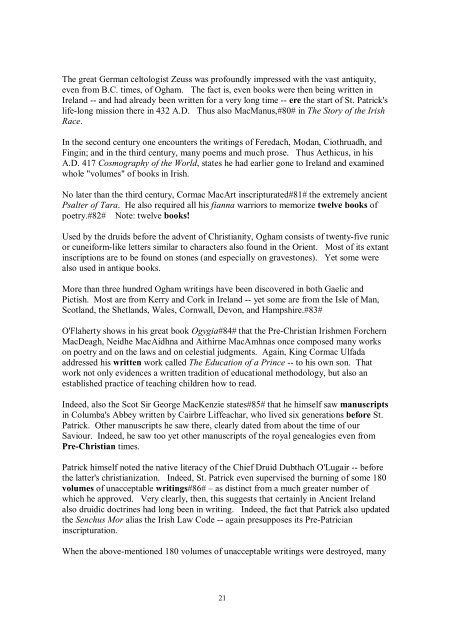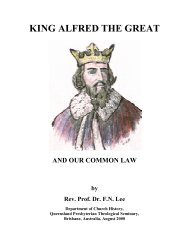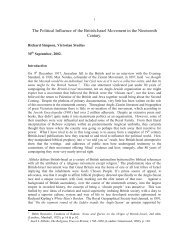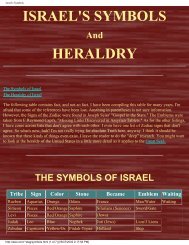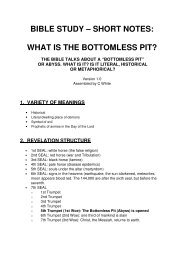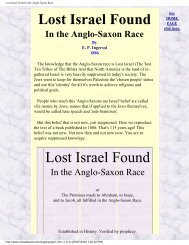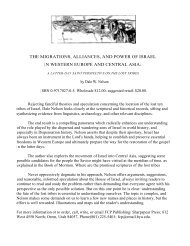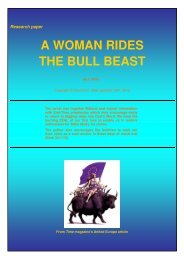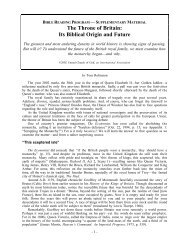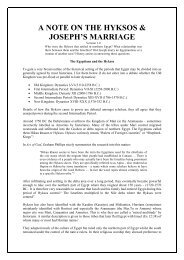CH. 6. COMMON LAW AMONG THE ANCIENT ... - Origin of Nations
CH. 6. COMMON LAW AMONG THE ANCIENT ... - Origin of Nations
CH. 6. COMMON LAW AMONG THE ANCIENT ... - Origin of Nations
You also want an ePaper? Increase the reach of your titles
YUMPU automatically turns print PDFs into web optimized ePapers that Google loves.
The great German celtologist Zeuss was pr<strong>of</strong>oundly impressed with the vast antiquity,even from B.C. times, <strong>of</strong> Ogham. The fact is, even books were then being written inIreland -- and had already been written for a very long time -- ere the start <strong>of</strong> St. Patrick'slife-long mission there in 432 A.D. Thus also MacManus,#80# in The Story <strong>of</strong> the IrishRace.In the second century one encounters the writings <strong>of</strong> Feredach, Modan, Ciothruadh, andFingin; and in the third century, many poems and much prose. Thus Aethicus, in hisA.D. 417 Cosmography <strong>of</strong> the World, states he had earlier gone to Ireland and examinedwhole "volumes" <strong>of</strong> books in Irish.No later than the third century, Cormac MacArt inscripturated#81# the extremely ancientPsalter <strong>of</strong> Tara. He also required all his fianna warriors to memorize twelve books <strong>of</strong>poetry.#82# Note: twelve books!Used by the druids before the advent <strong>of</strong> Christianity, Ogham consists <strong>of</strong> twenty-five runicor cuneiform-like letters similar to characters also found in the Orient. Most <strong>of</strong> its extantinscriptions are to be found on stones (and especially on gravestones). Yet some werealso used in antique books.More than three hundred Ogham writings have been discovered in both Gaelic andPictish. Most are from Kerry and Cork in Ireland -- yet some are from the Isle <strong>of</strong> Man,Scotland, the Shetlands, Wales, Cornwall, Devon, and Hampshire.#83#O'Flaherty shows in his great book Ogygia#84# that the Pre-Christian Irishmen ForchernMacDeagh, Neidhe MacAidhna and Aithirne MacAmhnas once composed many workson poetry and on the laws and on celestial judgments. Again, King Cormac Ulfadaaddressed his written work called The Education <strong>of</strong> a Prince -- to his own son. Thatwork not only evidences a written tradition <strong>of</strong> educational methodology, but also anestablished practice <strong>of</strong> teaching children how to read.Indeed, also the Scot Sir George MacKenzie states#85# that he himself saw manuscriptsin Columba's Abbey written by Cairbre Liffeachar, who lived six generations before St.Patrick. Other manuscripts he saw there, clearly dated from about the time <strong>of</strong> ourSaviour. Indeed, he saw too yet other manuscripts <strong>of</strong> the royal genealogies even fromPre-Christian times.Patrick himself noted the native literacy <strong>of</strong> the Chief Druid Dubthach O'Lugair -- beforethe latter's christianization. Indeed, St. Patrick even supervised the burning <strong>of</strong> some 180volumes <strong>of</strong> unacceptable writings#86# – as distinct from a much greater number <strong>of</strong>which he approved. Very clearly, then, this suggests that certainly in Ancient Irelandalso druidic doctrines had long been in writing. Indeed, the fact that Patrick also updatedthe Senchus Mor alias the Irish Law Code -- again presupposes its Pre-Patricianinscripturation.When the above-mentioned 180 volumes <strong>of</strong> unacceptable writings were destroyed, many21


